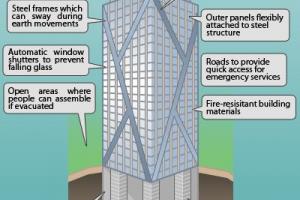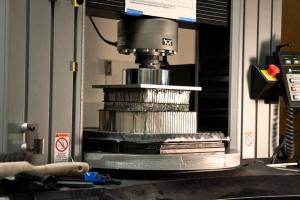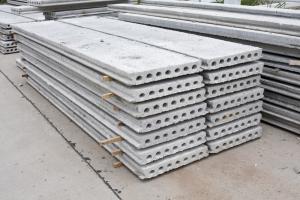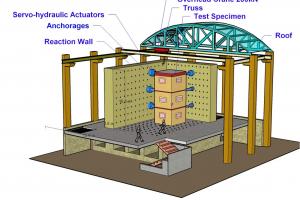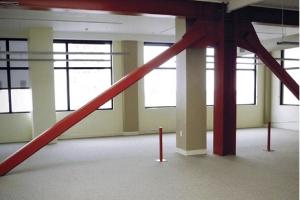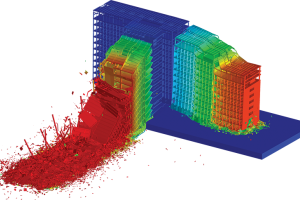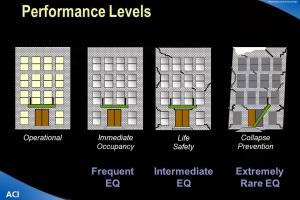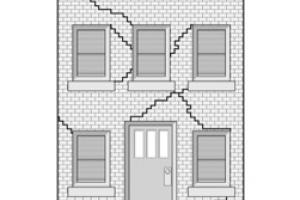Effects of Earthquake on Unreinforced Masonry Buildings
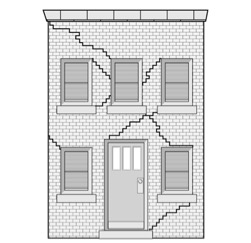
Earthquakes can have severe effects on unreinforced masonry (URM) buildings due to their vulnerability to seismic forces. Unreinforced masonry refers to buildings constructed primarily using bricks, stones, or concrete blocks without the incorporation of steel reinforcement or other structural elements to resist lateral loads. Here are some of the potential effects of earthquakes on URM buildings:
Connection failure
Unreinforced masonry buildings often lack proper connections between structural elements, such as walls, floors, and roofs. During an earthquake, the shaking motion can cause these connections to fail. For example, the bond between the masonry walls and the foundation may weaken or break, leading to a loss of support and stability. For the given direction of the earthquake, wall A acts as a shear wall and B acts as a flexure wall. If the walls are not tied together wall B overturns (out of plane) and wall A slides (in plane) and collapse occurs. Masonry units should be tied properly.
Lack of connection between orthogonal walls
Unreinforced masonry buildings typically consist of orthogonal (perpendicular) walls that intersect at corners. The lack of proper connections between these walls can result in their separation or dislocation during an earthquake. The shaking forces can cause the walls to shift or rotate, leading to partial or complete collapse of the building.
Such type of failure was among the most common, resulting from out-of-plane vibration of the walls. As the wall bends outward the intersecting perpendicular walls offer a restraint that relies on the tensile strength of masonry, which eventually cracks. The intersection of orthogonal walls is also characterized by shear stresses due to flange-web action that can further facilitate cracking. URM buildings lack the ductility and strength to withstand the lateral forces and ground motion generated by an earthquake. They tend to crack and disintegrate, increasing the risk of injury and fatalities for occupants.
Damage at wall-to-roof connections
The interface between masonry walls and the roof is another vulnerable area in unreinforced masonry buildings. The shaking during an earthquake can cause detachment or failure at the wall-to-roof connections. This can result in the roof collapsing onto the floors below or the walls losing their support, increasing the risk of structural failure.
Damage of such type occurs as a result of the forces transmitted between walls and roof, mostly due to out-of-plane horizontal excitation of the walls but also to vertical ground accelerations which could be very high in localities very close to the fault rupture (e.g. Balakot). The top of the wall may slip out from underneath the roof and/or crush under dynamic loading, particularly in the case of poor-quality masonry (rubble stone) and relatively heavy and rigid roofs that are not properly connected. Also, in the case of light roofs, the friction under the roof bearing may not be sufficient to avoid slippage.
In-plane failures
Unreinforced masonry walls are more resistant to vertical loads compared to lateral forces, such as those generated during an earthquake. The walls can experience in-plane failures, where they buckle or crack due to the lateral forces exerted by the seismic waves. This can lead to the collapse of sections of the walls, compromising the overall stability of the building.
When the Earthquake force is parallel to the plane. The wall experiences shear-off or bending. X- cracks occur in the walls along with vertical cracks at wall intersections, separation of corners of two walls, spalling of materials, etc. In-plane diagonal cracks and X-diagonal cracks result from shear forces in the plane of the walls. The development of these cracks is related to an overall response of the building, foundation, and its soil: depending on the level of drift demand, the damage can be moderate and easily repairable, or severe to the extent that the buildings are usually unfit for further use, but the consequence to the people are significantly less serious than in the case of out of plane wall overturning
Out-of-plane failure
Out-of-plane failures occur when unreinforced masonry walls fail to withstand the lateral forces exerted during an earthquake, causing them to lean, bulge, or collapse outward. The lack of reinforcing elements makes the walls susceptible to such failures, resulting in significant damage to the building and posing a hazard to occupants and neighboring structures.
The Earthquake force is perpendicular to the plane. The wall tends to overturn or bend. This causes the partial or full collapse of the wall. This is due to Inadequate anchorage of walls and roofs, long and slender walls, etc. Characterized by vertical cracks at the corner, cracks at the lintel, roof level, and gable wall, etc. Out-of-plane lateral thrust at roof level due to inclined roofs adding to inertial forces is also a significant cause of the collapse of masonry structures. In addition to the roof lateral thrust, another observed reason for out-of-plane failures is the lack of connection between walls and supporting roof, neither any restraints are provided nor any ring beam.
URM walls can deform out-of-plane, meaning they may buckle or lean, leading to structural instability. This can result in a building tilting or leaning dangerously, making it uninhabitable and unsafe.
Failure due to openings in the Wall
Unreinforced masonry walls often contain openings, such as windows and doors. These openings can weaken the structural integrity of the walls, especially during an earthquake. The concentrated stresses around the openings can lead to cracking or complete failure, compromising the stability of the entire wall or adjacent sections.
The opening will obstruct the flow of forces from one wall to another. A large opening in the shear wall reduces the strength of the wall against the inertia forces. Results diagonal cracks in the areas of masonry between the opening and cracks at the level of the opening. Thus, openings should be small and away from corners. These cracks (Figure 4) can be a result of both in-plane shear forces and out-of-plane flexure of the wall and are initiated by stress concentration at the corners of the openings.
They are not particularly serious unless the relative displacement across the cracks is large, in which case instability of the section of the wall above the opening becomes an issue. Masonry walls in URM buildings are prone to extensive cracking and damage due to the brittle nature of the materials. Cracks can compromise the structural integrity and allow water infiltration, leading to long-term degradation.
Diaphragm-related failures
The diaphragm refers to the horizontal elements (such as floors and roofs) that provide lateral stability to a building. In unreinforced masonry structures, the diaphragm can experience failures during earthquakes. The shaking motion can cause the diaphragm to crack, detach, or collapse, further compromising the overall stability of the building and potentially leading to progressive collapse.
Lack of anchoring produces a push of the diaphragm against the wall. The absence of good shear transfer between diaphragms and reaction walls accounts for damage at the corner of the wall. A rare phenomenon in the event of seismic motion. Separation of wall and diaphragm causes a collapse of buildings. (Javed et al., 2006)
These various modes of failure highlight the significant vulnerabilities of unreinforced masonry buildings during seismic events. Implementing retrofitting strategies and reinforcing these structures can help enhance their seismic performance and reduce the risks associated with earthquakes.



